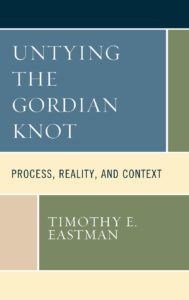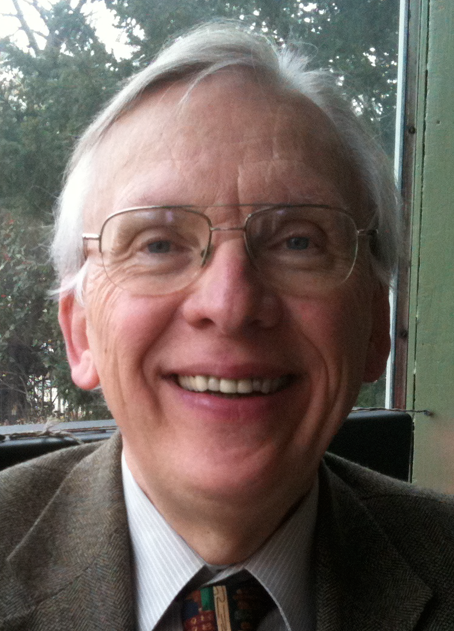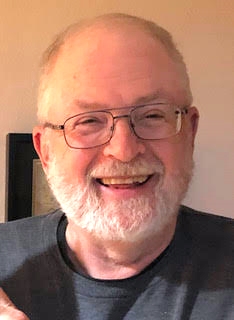Timothy E. Eastman. Untying the Gordian Knot: Process, Reality, and Context. Lexington Books, The Rowan and Littlefield Publishing Group, 2020. 344 pages. Reviewed by John M. Sweeney, Center for Process Studies, retired; Docent, Big Bear Alpine Zoo. E-mail: [email protected]


In Untying the Gordian Knot, Dr. Timothy E. Eastman, a plasma physicist by vocation and a philosopher by avocation, provides a framework within which all forms of knowledge, information, experience, can be integrated. As Eastman notes in Chapter 1, this “Quest” for comprehensiveness began in his youth, continued through his professional career with its many adventures and publications (both in science and philosophy), and continues in his retirement. Untying the Gordian Knot is Eastman’s “attempt to satisfy my naïve yet profound youthful aspiration to find a framework that could articulate the full experience of that (youthful) moment, the material, the interactive and aesthetic, and the spiritual” (p. 3).
Throughout the eight chapters of this book, Eastman develops his framework, called Logoi; describes the Gordian Knot set of problems (a baker’s dozen, hence 13; the set can be found on pp. 66-67); and applies the Logoi framework to the various components of the Gordian set.
In Chapter One, “Quest,” Eastman presents some of the various influences that have guided him in his search for integrating all of experience. He also proposes three ways of knowing: (1) the way of numbers (quantitative, and much of science); (2) the way of context (arts and the humanities; qualitative): and (3) the way of spirit (ultimate matters, spiritual). Eastman suggests a “Gordian Knot” as a way of summarizing “a seemingly intractable cluster of related problems” that may be solved through new, creative approaches. Logoi (yes, the plural of Logos) is introduced as a way of describing Eastman’s inclusive, relational view of reality. Eastman intends the Logoi framework to point “to an ecological vision of the world, interrelated and multilevel” (p. 17) that includes science, aesthetics, myth, and other modes of problem-solving.
Chapter Two, “Relations—Logoi” begins explaining the complex detail regarding various aspects of Eastman’s proposed Logoi framework. Some of these aspects include process/succession, logic, potential relations (potentiae), ways of knowing (see above), and more. Further, associated with each of the aspects are facets that contribute to the aspect, and to that aspect’s relationships with the other aspects.
Chapter Three, “Gordian Knot to Logoi Framework” describes the set of Gordian Knots to which the Logoi framework will be applied, beginning in this chapter and continuing in subsequent chapters. These Knots include, but are not limited to, issues involving causation, induction, knowledge, emergence, potentiality, and the mind-body problem (historically, perhaps the most vexing Gordian Knot).
In Chapters Four through Seven, Eastman demonstrates how the Logoi framework can begin to be applied to the set of Gordian Knots. Also. in these chapters Eastman incorporates recent developments in physics, logic, semiotics, and other fields into the Logoi framework. Chapter Four focuses on “Causation, Emergence, and Complex Systems”; it includes a review of a number of previous views that have hindered a better understanding of causation, emergence, and complexity. Applying recent developments in physics and using the Logoi framework, Eastman shows how these impediments can be averted.
In Chapter Five, “Information and Semiotics” are added to the Logoi framework. Eastman explores the many and varied connections among causation, emergence, physical relations, complex systems, information, and semiotics (the theory of signs). Also in this chapter, Eastman explores connections between process thought and semiotics.
As Chapter Six’s title, “Complex Whole,” suggests, the complexity of all experience is explored from a variety of perspectives: geology, physics (plasma), decision-making, measurement problems, etc. Eastman is clear that his discussions are merely a beginning, and that there are many perspectives for interpreting the complexity of the whole.
Chapter Seven, “Peirce’s Triads and Whitehead’s Process: Fundamental Triads and Schemas,” presents discussions of the following topics: (1) the triadic nature of reality as found in Peirce, Chu-Hsi’s neo-Confucianism, James Bradley, Aaron Gare, and Whitehead; (2) a comparison of other frameworks, such as classical metaphysics, with the Logoi framework (p. 324); and (3) the mind-brain relationship, including parapsychological possibilities.
Chapter Eight, “Contextuality—From Experience to Meaning” provides both a summary of the previous chapters and further integration. This further integration highlights the second and third ways of knowing, those of aesthetics (arts and humanities) and of spirituality (ultimate boundaries/contexts). These latter two ways of knowing have been discussed in previous chapters, but in this chapter, they are more prominent than previously.
Both the Appendix and the Bibliography are helpful and impressive. The Appendix (p. 279) contains Further Reading suggestions for each chapter. The bibliography (p. 285) is truly comprehensive, both works cited and works consulted.
Among A.N. Whitehead’s numerous, helpful suggestions are the following:
It is easy enough to find a theory, logically harmonious and with important applications in the region of fact, provided that you are content to disregard half your evidence. (Science and the Modern World, p. 187)
The aim of science is to seek the simplest explanations of complex facts. We are apt to fall into the error of thinking that the facts are simple because simplicity is the goal of our quest. The guiding motto in the life of every natural philosopher should be, Seek simplicity and distrust it. (Concept of Nature, p. 163)
In Untying the Gordian Knot, Dr. Eastman follows both of these suggestions. Evidence is not disregarded. In fact, the goal of this book, as mentioned earlier, is to provide a framework that accounts for all of experience. Yet Eastman does not claim that he is seeking completeness, Further Eastman often acknowledges the amazing complexity of experience, and that complexity can seem overwhelming at times. In line with Whitehead’s second suggestion above, and in keeping with both his scientific vocation and philosophical avocation, Eastman has “the more modest hope that this proposal (the Logoi framework) will encourage new ways of seeing the world, and will provide a new perspective on its complexities, one that will open new spaces for further inquiry (p. 3).” We can hope that the current world troubles (climate degradation, wars, greed, etc.) subside enough that Eastman’s proposal is given a chance to work, to promote ecological civilization (p. 247).

